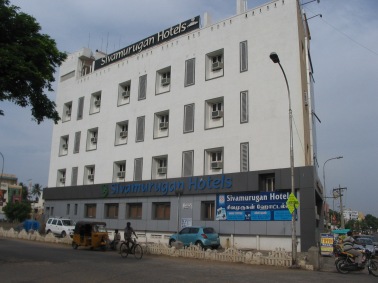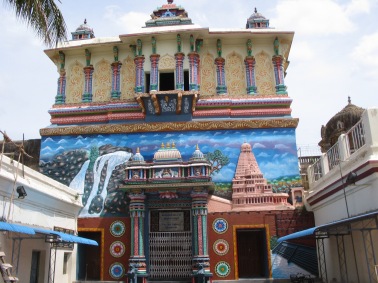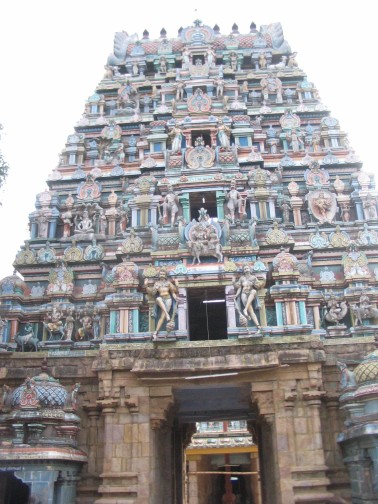Kumbakonam – Thanjavur (2 days) – July 2012 – Day I
Thanjavur has been on my radar since the time we visited Pondicherry. On the way to Chidambaram, I had noticed a lot of buses commuting to Thanjavur also, and that it wasn’t far from there! So this destination lay at the back of my mind for quite some time. This time when looking for places to go, we figured: why not go to Thanjavur?
When searching up on the internet about travel plans from Bangalore, we found that a lot of people stayed at Kumbakonam, and travelled to Thanjavur from there, as it made traveling to nearby temples easier. Ok. So Kumbakonam it was to stay!
We took a Friday late evening bus from Shantinagar bus stop to Kumbakonam. We were supposed to reach at about 6.30am, but managed to reach only past 8am. We had already made a phone booking at Hotel Sivamurugan close to the bus stand. Though the guy on the phone had assured us it was “very close” to the bus stand, we were still a bit apprehensive. However, when we got off the bus, we were quite surprised to find that the guy was actually right. In fact, we could see it from the bus stop, and took us about 5 minutes to reach the hotel.
Since we were late, and my phone had conked off and was unreachable, the hotel had given our booking off to someone else. But we still got a room, though smaller than the original one. Didnt really matter much to us anyway! Once we got ready, we asked the hotel to arrange for a taxi to take us around. After a 15 minute wait, the cab came by. We had originally planned a 1/2 day trip. By that we’d assumed that it meant the driver would be with us for 6 hrs. It actually meant that he would be with us till 1pm. So if we wanted 6hrs, we should have stepped out of the hotel at 7am approx! Not very fair, but that’s the policy!
Once in the cab, we worked out a whole day deal with the cab driver. The schedule was set up to be Thanjavur, and some temples near Kumbakonam.
First stop was the Brihadeeswara temple, popularly known as The Big Temple, at Thanjavur. By the time we reached the temple it was already 12pm. We had to hurry up to get inside the temple, as the doors would close for the afternoon, and that would mean a 4 hr wait for us. So, we hurried. Of course, once we deposited our slippers at the shoe stand, hurrying became a moot point. The stone walkway scorched our feet. We were literally dancing around to prevent our feet from burning! 😦
After a rushed trip to the temple entrance, we found ourselves just staring at the huge shivalinga of Lord Brihadeeswara in the distance. It was a beautiful, beautiful sight. Then we remembered to enter the temple in time for darshan. We had picked up a basket for archana. But when we gave it to the priest, he merely took the basket, and returned some veepudi and kumkuma saying it was the prasadam. Normally the process is that we give our names and gothram to be read for archana. But either they were short of time, or I don’t know what, they just hurried us out of the temple. Anyway, we wanted to make the offering to the Lord and have his Darshan, we got that wish.
At this point, we were a little free to actually look at the temple and admire its majesty. It is one of the tallest temples in India, with a vimana hight of 216 ft. It is also part of UNESCO’s World Heritage Sites: Great Living Chola Temples. There was a bit of a controversy regarding the kalash on top of the gopuram, whether it was a single stone piece, which it isn’t. This temple turned 1000 yrs old in 2010. Also there is a huge Nandi facing the temple, which has been carved out of a single stone. The temples are really beautiful, and we really enjoyed walking around, when we weren’t running for cover from the sun and burning hot stone.
All around the temple is a covered passage/corridor where mythological motifs have been painted with shivalinga in the foreground to support the story told. Most of these frescoes have been destroyed, and no attempt seems to have been made to restore them. That, I think, was the only down point of the entire temple visit.
It was 1pm by the time we got out of the temple. Since every other monument would be shut down for lunch during this time, we proceeded to have lunch. The driver took us to this small vegetarian restaurant where they served meals. The food wasn’t the best, and we weren’t very happy about eating there.
After lunch we went to check if the museum and palace were open for viewing.
We first stopped at the Sarasvathi Mahal, the library of the Thanjavur Palace. This was established around 1700 CE, and contains over 30,000 manuscripts Indian and European manuscripts written on palm-leaves and paper. After spending some time admiring the miniature pictorial manuscripts on palm-leaf, we made our way to the main palace.
There are 2 parts of the palace: the art gallery and the bell tower. The art gallery was shut for lunch, and there was a paid entrance to the bell tower, but only upto the 3rd floor. The remaining floors were shut to visitors. We didn’t really see any point in making the climb, giving the awful way the place seemed to be maintained. Instead we found the Government Handicraft Emporium located in the Sangeeta mahal palace section, and decided to give that a tour. After a few minutes of walking through the exhibition, we made our way back to the cab.
The next stop was the Subramanya Swamy temple at Swamimalai near Kumbakonam. The temple doors hadn’t opened yet, so we took the excuse to rest in the courtyard of the temple. We were, of course, not the only ones. A lot of devotees were resting within the premises, waiting for the temple to open at 5pm. The shire of Subramanya Swamy is built at an elevation, and one needs to climb 2 flights of stairs to be able to take darshan.
Next stop was a Shiva Temple near the Sooriyan Temple. It is customary to visit a Shiva temple/shrine before taking darshan on any of the Navagrahas (The Nine Planets). Hence, prior to visiting the Sooriyan temple, we visited the Shiva Temple close by. After a short visit, where an attendant directed us through the various sections of the temple including archana offering to the Lord Shiva, we left for the Sooriyan temple.
Sooriyan, as the Sun God is called in Tamil, is the first God among the Navagrahas, and hence the visits to the Navagraha temples start with visiting a Shiva Temple. Most of the Navagraha temples have a Shiva linga within the temple, which people can pray to first before taking darshan of the Graha. However, the Sooriyan temple doesn’t have a Shivalingam within its walls. What it does have are different shrines for the various other Grahas. So we have to visit the Shiva temple first, and them come to the Sooriyan Temple, where we get darshan of all the Navagrahas in 1 temple.
The purpose of visiting the Navagrahas wasn’t very clear to us initially. We thought that one could visit a specific temple if they have a Dosha related to that particular planet. However, the reason is something different. The Navagrahas in each of the temples is depicted with their Consort/s. So they are supposed to be in a peaceful state of mind, and therefore willing to grant the seeker their wishes. Each of the Grahas represent an astrological sign, and are said control certain functions/problems of the human body. Hence worshipping at these temples would remove those barriers from one’s way, immaterial if it is a problem at that moment or not.
A brief about the temples:
| Navagraha – Location | Consorts | Presiding deities | Adidevatha | Colour | Vahana | Rasi and Direction |
| Surya (The Sun) – Suriyanar Koil | Usha, Prathyusha | Puranavaradheeswarar and his consort Mangalanayaki | Agni | Red | a chariot drawn by seven horses | Lord of Simma Rasi and occupies the central place amongst the navagrahas |
| Chandra ( The Moon) – Thingaloor | Rohini | Kailasanathar and his consort Periyanayakiamman | water | white | white horse | Lord of Kadaga Rasi and he faces the South-East direction. |
| Angaraka ( Sewai, Mars ) – Vaitheeswarankoil | Malini, Susilini | Vaidyanathan and his consort Thaiyal Nayaki | Boomidevi | red | the ram | Lord of Mesha and Vrichika Rasi and he faces South direction |
| Budan ( The mercury) – Trivenkadu | Ilai | Swedharanyeshwarar and his consort Ambal. | Vishnu | light green | the horse | Lord of Mithunam and Kanni Rasi and he faces the North-East direction |
| Guru ( The Vyazhan) (Jupiter) – Alangudi | Tharai, Sangini | Kasi Aaranyeswarar and his consort Elavarkuzhali | Brahma | yellow | elephant | Lord of Dhanusu and Meena Rasi and he faces North direction |
| Sukran (Velli) (The Venus) – Kanjanoor | Subakirthi, Sundari and Sringini | Agneeswarar and his consort Iswari | Dhanvanthri – Indra’s physician | white | the crocodile | Lord of Rishaba and Thula Rasi and faces East direction |
| Sani ( The Saturn) – Thirunallar | Neela Devi and Manga Devi | Dharbaranyeswarar (Swaymbumurti) and his consort Bogamartha Poon Mulayal | Yaman | black | the crow | Lord of Maharam and Kumba Rasis and faces the West direction |
| Raghu – Thirunageswaram | Nagavalli and Nagakanni | Naaganaadar and Girigujaambigai | Durga | black | blue lion | faces the South-West direction |
| Kethu – Keezhaperumpallam | Chitralekha | Naaganaadaswamy and his consort Ambal | Chitraguptan | red | eagle | faces the North-West direction |
Our next stop was the Govind Vitthala & Rukmini temple on the way back to Kumbakonam. A simple temple, with a huge hall space which is out-of-bounds for the visiting devotees, it was a quick darshan of the Lord.
From here we came back to Kumbakonam. Our first stop before returning to our hotel was the Adi Kumbeswara Temple.
The story behind this is the that of the Great Flood (funny how almost every religion in the world has a great flood). It is said that Lord Bramha put the seeds of life along with amrutham (nectar)within a pot (Kumbha) and placed it on top of Mount Meru (Mt Everest) just before the Great Flood. The flood however rose so high that it lifted the pot from the top of the mountain. Once it started subsiding, the pot travelled towards the South of India. It was finally put down at Kumbakonam. Lord Shiva, in the guise of a hunter, shot the pot with an arrow. The pot started spilling out the nectar while moving. The place where the pot cracked came to be known as Kumbakonam: Kumbha meaning pot, and Konam meaning cracked. The place where the amrutham first spilled out is called the Mahamaham Tank, also at Kumbakonam.
The Adi Kumbeswara temple is the place where the pot first cracked. The lingam here is said to have been made by Shiva himself in the guise of the hunter by mixing sand with the amrutham that spilled here. It was a beautiful temple, and it also features a huge painting on the wall of all the places where the amrutham fell. There is also a huge model of the temple, where we spent quite some time trying to understand. Unfortunately it was a little difficult for us, since the markings were entirely in Tamil! 🙂
The final stop pf the day was the Sarangapani Temple. This temple is dedicated to Lord Vishnu, and is one of the 108 important Vishnu temples, only 3rd after Srirangam and Tirupati. The temple is designed in the shape of a chariot drawn by horses and elephants. The main deity, Sarangapani, is actually the Utsava vigraha (or ceremonial figurine) where Vishnu hold a bow in his hand, as “Saranga” means “bow” in Sanskrit. The Moolavar (or diety in stone) is shown as reclining on Adisesha, flanked by Sridevi and Bhoodevi. There is a beautiful tank associated with this temple, and which separates it from the Adikumbeshwara temple. While we did not go to see it specifically, this particular tank is visible along the road when passing by the 2 temples.
This was a very quick visit to this temple, as it was already getting late, and the temple was getting ready to shut down for the night.
We slowly made our way back to the hotel. We planned with the driver for the next morning, and after a light dinner at the hotel restaurant, we called it a night.
















